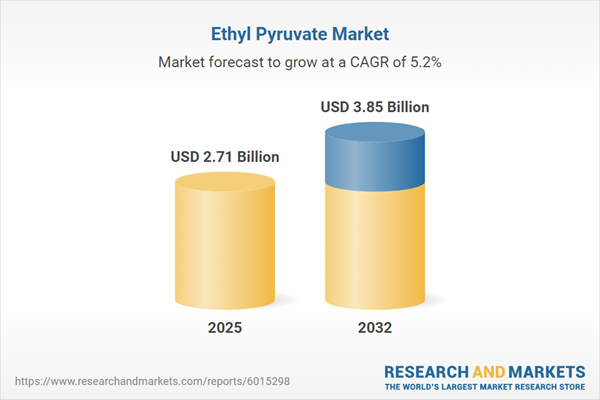Speak directly to the analyst to clarify any post sales queries you may have.
The ethyl pyruvate market is gaining momentum among senior decision-makers seeking new avenues for operational efficiency and compliance-driven innovation. As organizations across industries look for strategic solutions to boost sustainability, ethyl pyruvate presents itself as a versatile input supporting enhanced processes and long-term value creation.
Market Snapshot: Ethyl Pyruvate Market Overview
The Ethyl Pyruvate Market is experiencing robust global growth, marked by consistently increasing valuation and a broadening market footprint. This expansion reflects widespread recognition of the compound's antioxidant and anti-inflammatory properties, which are being utilized across pharmaceuticals, specialty chemicals, and related sectors. Industry participants are responding to regulatory shifts and evolving end-user needs by developing innovative products and adapting investments for maximum competitive leverage. Current market dynamics are shaped by enhanced collaboration, application-driven innovation, and alignment with new compliance expectations.
Scope & Segmentation of the Ethyl Pyruvate Market
This comprehensive assessment outlines the core segments and drivers defining the ethyl pyruvate market for executive stakeholders:
- End Users: Chemical manufacturers seeking to scale production volumes; cosmetics companies developing advanced haircare and skincare products; food and beverage producers integrating ethyl pyruvate for functional differentiation; pharmaceutical providers and generics utilizing it to support new therapies; and research institutions expanding novel uses.
- Grade: Food grade catering to consumable applications; industrial grade designed for adjustable manufacturing processes; pharmaceutical grade meeting strict purity and clinical criteria.
- Purity: Multiple purity levels available to suit different sector requirements, from higher percentages above 99% for sensitive applications to customized lower ranges for compliance needs.
- Distribution Channel: Direct sales to enterprises; established partnerships with regional distributors; integration of digital sales tools to improve transaction speed and ordering efficiency.
- Form: Liquid format supporting flexibility in diverse formulations; powder form providing advantages in transport, storage, and complex production workflows.
- Regions: Americas (notably the United States, Canada, Brazil); Europe, Middle East & Africa (including markets such as the UK, Germany, South Africa); and Asia-Pacific (featuring China, India, Japan), each demonstrating distinct regulatory frameworks and consumer expectations.
- Leading Companies: Merck KGaA, Thermo Fisher Scientific Inc., Tokyo Chemical Industry Co., Ltd., Bio-Techne Corporation, Cayman Chemical Company, Santa Cruz Biotechnology, Inc., Abcam plc, BOC Sciences LLC, Spectrum Chemical Manufacturing Corp., and BioVision, Inc.—organizations focusing on technology investment and scaling operations.
Key Takeaways for Senior Decision-Makers
- Ethyl pyruvate enhances product and process adaptability, enabling companies to respond efficiently to new operational and regulatory requirements.
- Adoption of process innovations, including continuous flow manufacturing techniques and use of eco-friendly catalysts, drives greater production consistency and resource management.
- Effective supplier validation and audit readiness help organizations maintain compliance and support smooth market entry across regions.
- Strategic collaboration with domestic and international entities facilitates technology transfer and accelerates market penetration.
- Operational improvements—such as advanced solvent recovery and waste reduction—align with sustainability objectives and help companies meet environmental benchmarks.
- Deploying digital solutions throughout the supply chain improves transparency and resilience, supporting procurement goals and ongoing business continuity.
Tariff Impact on Global Supply Chains
Recent changes to United States import tariffs affecting chemical intermediates are encouraging organizations to modify sourcing and distribution strategies for ethyl pyruvate. Leaders are expanding supplier networks, formalizing procurement vetting protocols, and considering local or regional supply options to mitigate exposure to shifting global trade environments. Investment in digital infrastructure is increasing, supporting nimble inventory management and ensuring stable supply chain performance amid evolving policy landscapes.
Methodology & Data Sources
This analysis combines qualitative and quantitative market research. It draws from comparative industry publications, patent research, regulatory analysis, and expert interviews. Company financials and trusted sector references underpin the evaluation to deliver actionable intelligence for executive strategy.
Why This Report Matters
- Enables senior leaders to optimize operational approaches and compliance planning as new technologies and market trends emerge in the ethyl pyruvate sector.
- Prepares organizations to manage global tariff shifts and regulatory updates, supporting supply resilience and efficient workflows.
- Provides decision-ready insights designed to benchmark organizational performance and catalyze innovation-driven growth initiatives.
Conclusion
The ethyl pyruvate market’s trajectory is closely tied to advancements in technology and evolving compliance standards. Decision-makers who build strategies around sustainability and operational flexibility are well positioned to capitalize on emerging opportunities and reinforce their organizational strengths.
Additional Product Information:
- Purchase of this report includes 1 year online access with quarterly updates.
- This report can be updated on request. Please contact our Customer Experience team using the Ask a Question widget on our website.
Table of Contents
3. Executive Summary
4. Market Overview
7. Cumulative Impact of Artificial Intelligence 2025
Companies Mentioned
The companies profiled in this Ethyl Pyruvate market report include:- Merck KGaA
- Thermo Fisher Scientific Inc.
- Tokyo Chemical Industry Co., Ltd.
- Bio-Techne Corporation
- Cayman Chemical Company
- Santa Cruz Biotechnology, Inc.
- Abcam plc
- BOC Sciences LLC
- Spectrum Chemical Manufacturing Corp.
- BioVision, Inc.
Table Information
| Report Attribute | Details |
|---|---|
| No. of Pages | 188 |
| Published | October 2025 |
| Forecast Period | 2025 - 2032 |
| Estimated Market Value ( USD | $ 2.71 Billion |
| Forecasted Market Value ( USD | $ 3.85 Billion |
| Compound Annual Growth Rate | 5.1% |
| Regions Covered | Global |
| No. of Companies Mentioned | 11 |









